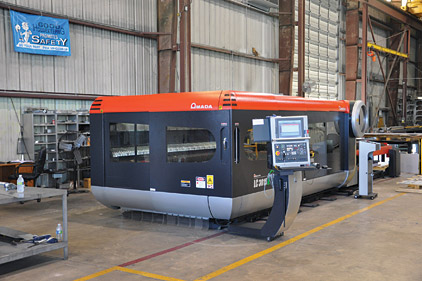
|
| With prices coming down, laser cutters, like this one at Custom Air Products & Services Inc., Houston, are becoming more affordable for many HVAC contractors who also handle sheet metal work. |
For contractors who have their own sheet metal shops, adding or replacing a tool such as a laser or plasma cutter can make a big difference in efficiency, time, and money. While adding or replacing a cutter can be a worthwhile investment, the style and model of cutter needs to be carefully researched, as such an investment carries quite a hefty price tag.
Choosing the Right Cutter
So, which cutter is best? Well, it depends on the size and scope of what you’re trying to accomplish and how much money you’re willing to spend.
Terry Roden, president, Teco Metal Products, Dallas, is about to take delivery of his third laser cutter. After starting his business in 1997, using a pair of snips, Roden quickly embraced the ease and simplicity of automated plasma cutters.
“When the first hand-held plasma cutter came out we thought it was heaven on earth,” he said. “The automated table-based plasma was a miracle machine.”
Roden eventually garnered three high-definition plasma cutters, but eventually began noticing faults, which left him searching for an alternative. “Over time, we discovered that plasma was dirty, slow, and it created a lot of smoke in the atmosphere,” he said.
That’s when he discovered laser cutters. “The cut speed was tripled. The one that’s about to hit the floor will cut at 1,200 inches per minute, and the traverse speed on it is 12,000 inches a minute,” Roden said. “So you can imagine how that picks up production.”
Custom Air Products & Services Inc., Houston, recently purchased a new laser cutter for its shop. Ken Villarrubia, general manager of manufacturing/fabrication, said replacing an older model with a newer version has helped the company increase production and decrease labor.
“We decided to step it up a notch to a higher-end unit,” he said. “It’s faster; that’s the bottom line. It has two loading tables instead of one. We can load up two tables worth, program it, and let it go.”
When it comes to choosing a cutter, Villarrubia acknowledged that sticking with laser cutters was a no-brainer. “The laser provides a much cleaner cut, bottom line,” Villarrubia said. “You’re not burning the material as much and it’s a cleaner, thinner, neater cut than you get on a plasma. We still use hand plasma machines if we have a unit we have to cut holes in that’s already standing or bent as it can’t easily be run through a machine. It’s almost like a torch, if you will, but the laser offers a finer cut.”
Roden said he was able to offset the production of three plasma cutters through one laser cutter. The addition of a second laser cutter pushed production to levels he never dreamed possible. “Our production increased to the point that I added an additional press and two additional welding stations,” he said.
Now, with his third cutter on the way, he’s excited for what lies ahead. “This cutter also features a shuttle table design, but this time it is a 4,000-W machine allowing us to cut material up to 1.25-inch thick,” Roden said. “The majority of our materials that we cut are 14-gauge galvanized, so this machine will eclipse the speed of the other two machines. It has a traverse speed of 12,000 inches per minute, with a cut speed on our material of over 800 inches per minute. Additionally, by switching all of our cutters to lasers, we have been able to broaden our capabilities and increase our customer base, allowing us to compete in markets requiring tolerances that even high-definition plasma cannot produce.”
And, like most technologies, the price is falling to more manageable levels. Villarrubia estimated the new cutter Custom Air purchased cost around $600,000.
“The pricing has become competitive,” Roden said. “Ten years ago, the laser I’m getting would’ve been in the $1.5 million range. The price has dropped to around $700,000. You can get an entry-level laser in the high $300,000s. Technology has come so far so fast. I’m amazed there are not more shops looking to drop plasmas and move to lasers.”
Without a doubt, Villarrubia said he intends to stick with lasers.
“Absolutely laser is the way to go,” he said. “It does everything we need it to do. It’s been very good for us. I highly recommend it.”
Publication date: 5/20/2013
Want more HVAC industry news and information? Join The NEWS on Facebook, Twitter, and LinkedIn today!








